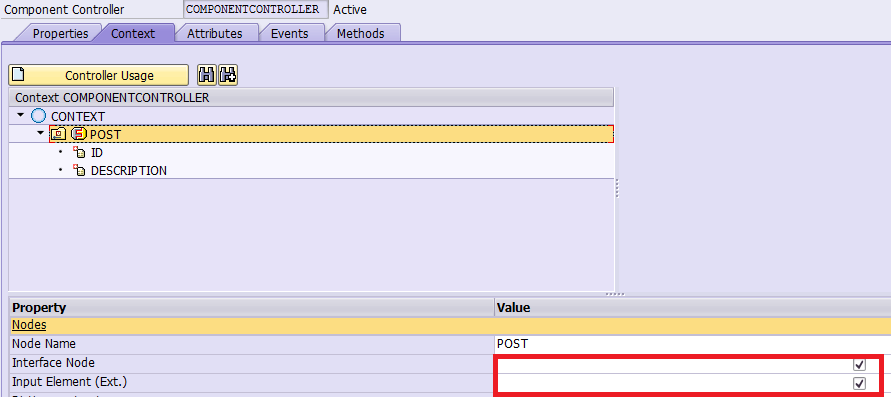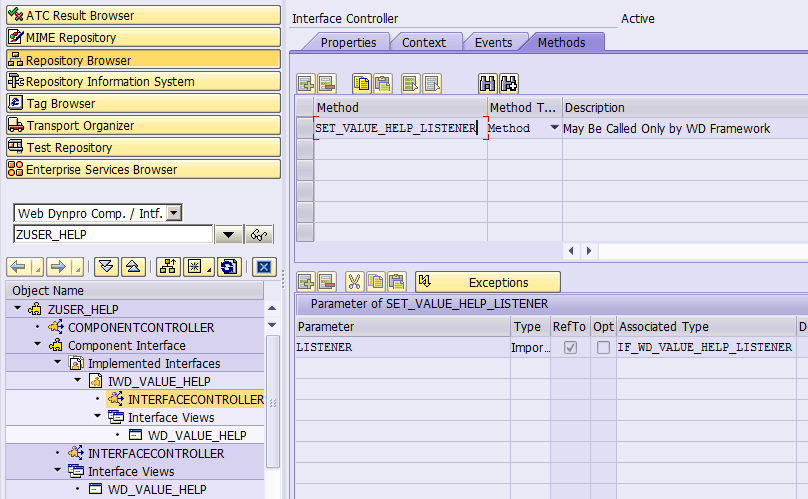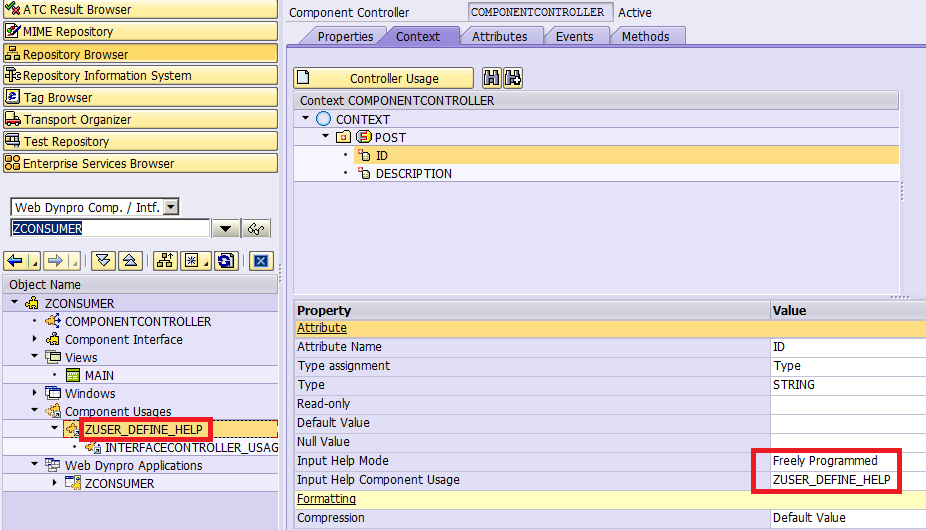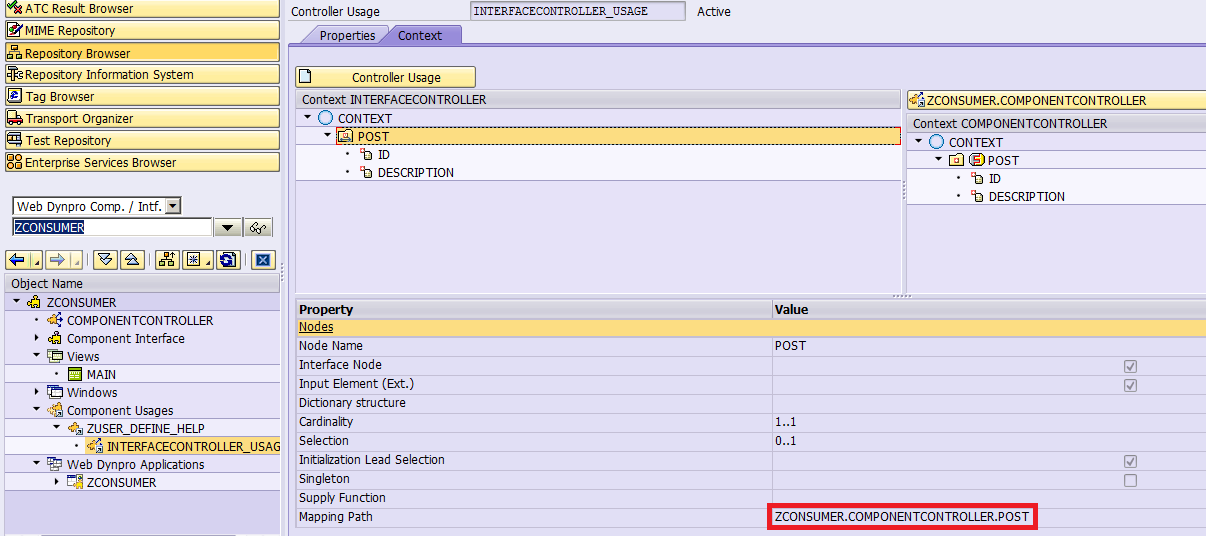This document explains how to read contents from .xlsx file. It explains reading file contents from .xlsx file by code snippets. Following are the steps explaining the procedure:-
- Define a Web Dynpro component with name for example ‘ZZDEV_WD_TEST’.
- Define File Upload UI element and a Button UI element in the main view.
![browse.jpg]()
- Create context node with attributes FILENAME (string), FILETYPE (string), FILECONTENTS (xstring).
![context.jpg]()
- Bind these to the File Upload UI element. Bind FILECONTENTS to DATA attribute, FILENAME to FILENAME attribute and FILETYPE to MIMETYPE attribute.
![binding.jpg]()
- Browse the .xlsx file and click on upload button.
- On action of upload button read the context node defined in step 3.
- Follow below code to read the browsed .xlsx file.
* Internal tables declaration
DATA:
lt_worksheets TYPE STANDARD TABLE OF string,
lt_contents TYPE string_table,
lt_final_contents TYPE <target structure table type>.
* Structures declarations
DATA:
ls_return TYPE bapiret1,
ls_contents TYPE <target structure>,
ls_file_upload TYPE wd_this->element_file_upload.
* Local variables declaration
DATA:
lv_name TYPE string,
lv_string TYPE string,
lv_msg TYPE string,
lv_flag TYPE boolean,
lv_message TYPE string.
* References declarations
DATA:
lref_excel TYPE REF TO cl_fdt_xl_spreadsheet,
lref_excel_core TYPE REF TO cx_fdt_excel_core,
lref_data TYPE REF TO data,
lref_dref TYPE REF TO data,
lo_nd_file_upload TYPE REF TO if_wd_context_node,
lo_el_file_upload TYPE REF TO if_wd_context_element.
* Field symbols declarations
FIELD-SYMBOLS:
<fs_table> TYPE table,
<fs_data> TYPE any,
<fs_data_str> TYPE any,
<fs_comp> TYPE any,
<fs_output> TYPE string.
* navigate from <CONTEXT> to <FILE_UPLOAD> via lead selection
lo_nd_file_upload = wd_context->get_child_node( name = wd_this->wdctx_file_upload ).
* get element via lead selection
lo_el_file_upload = lo_nd_file_upload->get_element( ).
* get all declared attributes
lo_el_file_upload->get_static_attributes(
IMPORTING
static_attributes = ls_file_upload ).
TRY.
* Create object of class to read .xlsx file contents
CREATE OBJECT lref_excel
EXPORTING
document_name = ls_file_upload-filename
xdocument = ls_file_upload-filecontents.
CATCH cx_fdt_excel_core INTO lref_excel_core.
CLEAR lv_msg.
* Call method to get error message text
CALL METHOD lref_excel_core->if_message~get_text
RECEIVING
result = lv_msg.
*<< Display error message returned in lv_msg >>
RETURN.
ENDTRY.
* Call method to get list of worksheets in the .xlsx file
lref_excel->if_fdt_doc_spreadsheet~get_worksheet_names(
IMPORTING
worksheet_names = lt_worksheets ).
* Condition to check whether .xlsx file has any active worksheets
IF lt_worksheets IS NOT INITIAL.
* Read active worksheet
READ TABLE lt_worksheets INDEX 1 INTO lv_ws_name.
ELSE.
*<< Display error message >>
RETURN.
ENDIF.
* Get reference of .xlsx file contents in the active worksheet
lref_data = lref_excel->if_fdt_doc_spreadsheet~get_itab_from_worksheet( lv_name).
* Fetch all records in the active worksheet
ASSIGN lref_data->* TO <fs_table>.
* Prepare exporting table with .xlsx file contents
IF <fs_table> IS NOT ASSIGNED.
*<< Display error message >>
RETURN.
ENDIF.
* Loop dynamic table to prepare final table contents to pass in exporting parameter
LOOP AT <fs_table> ASSIGNING <fs_data>.
* Initialize flag
lv_flag = abap_true.
WHILE lv_flag = abap_true.
* Read columnwise entries
ASSIGN COMPONENT sy-index OF STRUCTURE <fs_data> TO <fs_comp>.
IF <fs_comp> IS NOT ASSIGNED.
lv_flag = abap_false.
* Exit the loop when a row ends
EXIT.
ELSE.
* Concatenate each cell data in a row into string seperated by '||'
CONCATENATE lv_string <fs_comp> INTO lv_string SEPARATED BY '||'.
ENDIF.
* Unassign field symbol
UNASSIGN <fs_comp>.
ENDWHILE.
* Shift final string having a row left by 2 places to remove leading '||'
SHIFT lv_string LEFT BY 2 PLACES.
* Append prepared row data to exporting parameter
APPEND lv_string TO lt_contents.
* Clear variable having row data
CLEAR lv_string.
ENDLOOP.
* Loop internal table to split records and fill in target internal table
LOOP AT lt_contents ASSIGNING <fs_output>.
* Split file contents returned at '||'
SPLIT <fs_output>
AT '||'
INTO ls_contents-col1
ls_contents-col2
ls_contents-col3……..
* Append split records in internal table
APPEND ls_contents TO lt_final_contents.
ENDLOOP.
7. Contents will be appended to internal table LT_FINAL_CONTENTS. Define a structure in SE11 with fields corresponding to upload file structure and declare LS_CONTENTS of this type. Define a table type in SE11 with this structure and declare LT_FINAL_CONTENTS of this type.
8. Finally LT_FINAL_CONTENTS will have all the records present in the browsed .xlsx file.
Hope this solves reading file contents from .xlsx file.































